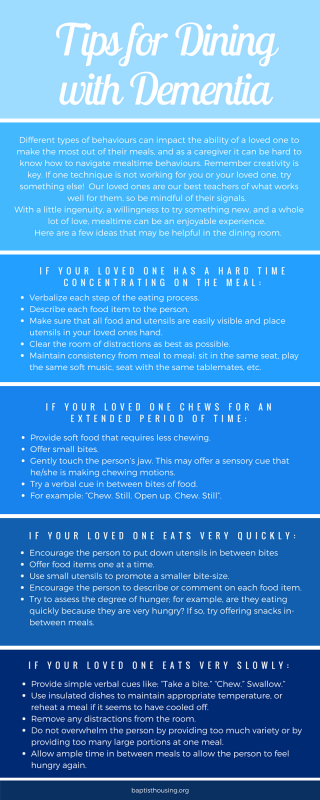Tips for Dining with Dementia

Dementia can change the way a person goes about their day. Certainly, mealtime is one of those everyday occurrences that may change with a diagnosis of dementia. Different types of behaviours can impact the ability of a loved one to make the most out of their meals, and as a caregiver it can be hard to know how to navigate mealtime behaviours. Here are a few ideas that may be helpful in the dining room:
If your loved one has a hard time concentrating on the meal:
-
Verbalize each step of the eating process.
-
Describe each food item to the person.
-
Make sure that all food and utensils are easily visible and place utensils in your loved ones hand.
-
Clear the room of distractions as best as possible.
-
Maintain consistency from meal to meal: sit in the same seat, play the same soft music, seat with the same tablemates, etc.
-
Provide soft food that requires less chewing.
-
Offer small bites.
-
Gently touch the person’s jaw. This may offer a sensory cue that he/she is making chewing motions.
-
Try a verbal cue in between bites of food. For example: “Chew. Still. Open up. Chew. Still”.
-
Encourage the person to put down utensils in between bites.
-
Offer food items one at a time.
-
Use small utensils to promote a smaller bite-size.
-
Encourage the person to describe or comment on each food item.
-
Try to assess the degree of hunger; for example, are they eating quickly because they are very hungry? If so, try offering snacks in-between meals.
-
Provide simple verbal cues like: “Take a bite.” “Chew.” “Swallow.”
-
Use insulated dishes to maintain appropriate temperature, or reheat a meal if it seems to have cooled off.
-
Remove any distractions from the room.
-
Do not overwhelm the person by providing too much variety or by providing too many large portions at one meal.
-
Allow ample time in between meals to allow the person to feel hungry again.
Remember creativity is key. If one technique is not working for you or your loved one, try something else! Our loved ones are our best teachers of what works well for them, so be mindful of their signals. With a little ingenuity, a willingness to try something new, and a whole lot of love, mealtime can be a very nutritious and enjoyable experience.
Print the PDF here.
Jessica Stewart RD, BSc. | Baptist Housing Clinical Dietitian